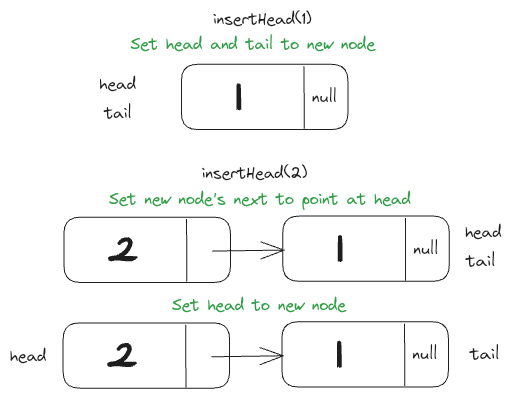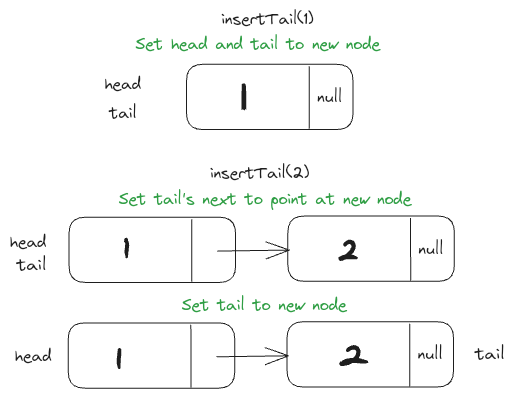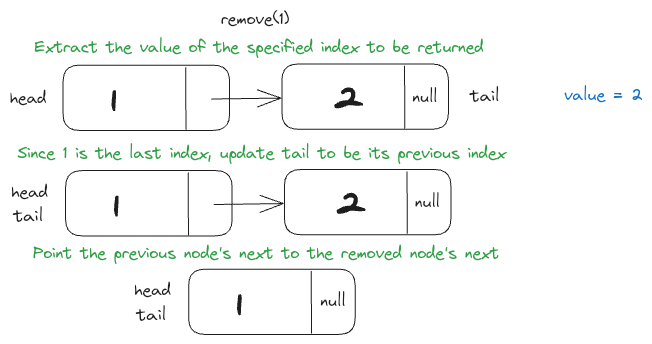Linked List
Implement a linked list data structure in JavaScript that contains the following operations:
new LinkedList(): Creates an instance of aLinkedListclass that does not contain any items. The constructor does not accept any arguments.get(): Accepts an integer parameterito return the value of thei-th node. Returnundefinedif index is out of bounds.insertHead(): Accepts a parametervalueand insertsvalueat the head of the list.insertTail(): Accepts a parametervalueand insertsvalueat the tail of the list.remove(): Accepts an integer parameteriand removes the item at thei-th index while returning its value. Returnundefinedif index is out of bounds.toArray(): Returns an array containing all the items in the linked list from head (first element in the array) to tail (last element in the array).length(): Returns the number of elements in the linked list.
Examples
const linkedlist = new LinkedList();linkedlist.toArray(); // []linkedlist.insertTail(1);linkedlist.insertHead(2);linkedlist.toArray(); // [2, 1]linkedlist.insertTail(3);linkedlist.toArray(); // [2, 1, 3]linkedlist.length(); // 3linkedlist.get(1); // 1linkedlist.get(2); // 3linkedlist.remove(1); // 1linkedlist.toArray(); // [2, 3]
Linked List (官方题解)
Solution
Linked lists are chains of connected nodes, where each node contains a value and a reference to the next node. The next in each node forms the links required to make linked lists.
In the LinkedList class, head and tail are used to indicate the start and end of the list. While using only head is possible, maintaining a tail pointer improves the time complexity of operations like insertTail() and enables efficient use cases such as implementing queues.
Insert
insertHead() and insertTail() involve updating the head or tail of the list to point to a new node.


Remove
remove() modifies the next reference of node i-1 to point to node i+1, effectively removing node i from the list. If the removed node is at the head or tail, the head or tail pointers are also updated accordingly.

Get and toArray
get() and toArray() traverse the list from the head node. get() stops at the specified index, while toArray() continues until the tail, collecting all values.
Length
length() traverses through the entire linked list to count the number of elements. Alternatively, a length variable can be maintained to track the length of the linked list every time a node is inserted/removed.
class Node {constructor(value, next = null) {this.value = value;this.next = next;}}export default class LinkedList {constructor() {this.head = null;this.tail = null;}/*** Adds an item to the head of the linked list.* @param {*} value The item to be added to the head of the list.*/insertHead(value) {const node = new Node(value, this.head);if (this.head == null) {this.tail = node;}this.head = node;}/*** Adds an item to the tail of the linked list.* @param {*} value The item to be added to the tail of the list.*/insertTail(value) {const node = new Node(value);if (this.tail == null) {this.head = node;} else {this.tail.next = node;}this.tail = node;}/*** Remove the item in the given index and return its value or `undefined` if index is out of bound.* @param {number} i The index of the item to be removed.* @return {*} The value of the item in index i if it exists, `undefined` otherwise.*/remove(i) {// To remove index 0, we have to replace the value of head, if it exists.if (i === 0 && this.head != null) {let value = this.head.value;this.head = this.head.next;if (this.head == null) {this.tail = null;} // If there is no node left in the linked list, replace tail with null as well.return value;}let curr = this.head; // Set a pointer to the first node of the linked list.// Point the pointer to the next node for i-1 times to reach index i-1.for (let j = 1; j < i; j++) {if (curr == null || curr.next == null) {return undefined;} // Return `undefined` if linked list ends before reaching index i.curr = curr.next; // Change the current pointer to the next one.}if (curr == null || curr.next == null) {return undefined;}let value = curr.next.value; // Save the value of the node in index i.curr.next = curr.next.next;// If curr.next, which is to be removed, is the last node in the linked list, update tail to the previous node (curr).this.tail = curr.next == null ? curr : this.tail;return value; // Return the value of the node in index i.}/*** Return the value of the item in the given index or `undefined` if index is out of bound.* @param {number} i The index of the value of the item to be returned.* @return {*} The value of the item in index i if it exists, `undefined` otherwise.*/get(i) {let curr = this.head; // Set a pointer to the first node of the linked list.// Point the pointer to the next node for i times to reach index i.for (let j = 0; j < i; j++) {if (curr == null) {return undefined;} // Return `undefined` if linked list ends before reaching index i.curr = curr.next; // Change the current pointer to the next one.}let value = curr != null ? curr.value : undefined;return value; // Return the value of the node in index i.}/*** Return an array containing all the values of the items in the linked list from head to tail.* @return {*} The array of all the values in the linked list from head to tail.*/toArray() {const array = [];let curr = this.head; // Set a pointer to the first node of the linked list.// Continue to traverse through the linked list until it reaches the tail (null).while (curr != null) {array.push(curr.value);curr = curr.next; // Change the current pointer to the next one.}return array;}/*** Return the length / number of elements in the linked list.* @return {*} Length of the linked list.*/length() {let length = 0;let curr = this.head;while (curr) {length += 1;curr = curr.next;}return length;}}
Big-O analysis
Let's analyze the algorithm's time and space complexity.
Time complexity
insertHead()andinsertTail(): O(1) as we can accessheadandtailimmediately.get(),remove(),toArray(): O(n) as the worst case is to traverse through the entire linked list to search for the specific index forget()andremove().length(): O(n) if traversing the entire array to calculate length, O(1) if maintaining a length variable.
Space complexity
- All methods require O(1) space, as no additional data structures are created that grow with input size.
Edge Cases
- Empty list: When operating on an empty list,
insertHead()andinsertTail()must set bothheadandtail. - Invalid index: In
get()andremove(), index values less than 0 or greater than or equal to the list length must be handled gracefully. One common approach is to returnundefined, as used in this problem.
Techniques
- Object-oriented programming.
加载编辑器
加载编辑器
加载测试
JavaScript 控制台
console.log() 语句将显示在此处。